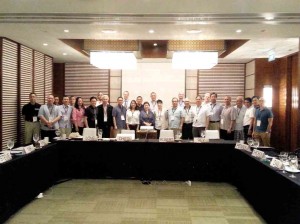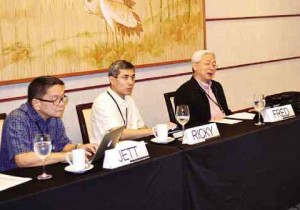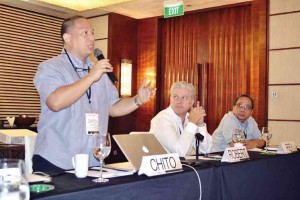Schools, industries seek ways to reduce unemployment of college graduates

REFORM PARTNERS As members of the National Industry-Academe Council, university presidents and industry and government representatives map out a three- to five-year higher education reform agenda that aims to curb youth unemployment and produce a globally competitive work force.
With sweeping basic education reforms set in motion, the country’s top university presidents and industry leaders want to make sure the problem of unemployment among college graduates is not overlooked.
The Philippines’ youth unemployment rate was placed at 16 percent in the second quarter of 2012, albeit lower than the 16.6 percent recorded in the same period in 2011.
“[Studies show that] the largest groups of unemployed or underemployed in the Philippines today, despite the massive economic growth, are college graduates. That statistic alone should be a wake-up call,” said Mir Tillah, education specialist of the United States Agency for International Development (USAID), in a recent meeting of the National Industry-Academe Council (IA Council).
The meeting, organized by the Philippine Business for Education (PBEd) and USAID at Shangri-La’s Boracay Resort and Spa, identified a three- to five-year industry-academe agenda toward higher education reforms.
When college graduates could not find employment, their parents’ investment on four to five years of education would go down the drain, the experts said.
Article continues after this advertisement“[This] results in a massive inefficiency in our economy because these things could have been put together to better use to supply the Microsofts, the IBMs, the SMEs (small- and medium-scale enterprises),” Tillah said.
Article continues after this advertisementWhile personal factors like attitude and behavior could adversely affect employment chances, incompetency and the lack of skills for jobs available were often the reasons for graduates’ failure to land jobs.
‘Business-ready’ graduates
University of the Philippines president Alfredo Pascual said the alarming figures of youth unemployment and the pressures of globalization were compelling higher education institutions (HEIs) to produce graduates that were “business-ready.”
He described these graduates as “those who can be readily employed right after graduation which, in effect, relieves the industry of its traditional function of providing the initial training for its recruits.”
A 2011 World Bank study, “Skills and Research for Growth in East Asia,” found that tertiary education failed to meet its potential because HEIs were operating as “disconnected individual institutions,” rather than as parts of a larger ecosystem that included employers and companies, said PBEd president Chito Salazar.
The National Industry-Academe Council, established in July, is a forum where the academe and industry can sit down and talk to discuss ways to bridge gaps in the school-to-work transition.
It resulted from PBEd’s Higher Education Summit earlier this year that was attended by university presidents and representatives of the government and the private sector.
Industry involvement
The summit underscored again skills gaps and mismatches and the need for industry to be closely involved in higher education reforms to reduce unemployment and prepare the country’s labor force for the tough competition expected in the Association of Southeast Asian Nations (Asean) 2015.
Participants in the IA Council meeting said linkage between industry and HEIs should grow beyond the 150- to 300-hour summer on-the-job training (OJT) and annual scholarships. Companies should develop partnerships with HEIs not just as corporate social responsibility (CSR) programs but as investments.
Industry’s involvement in academic reforms should be a business strategy, not just a CSR project, the IA Council added.
PBEd proposed a public-private partnership, the Philippine Pact for Youth
Employment, patterned after the German model of apprenticeship. Students would be recognized as employees and would be regularly paid. They would spend 80 percent of their time in a company and 20 percent in school.
Apprentices would be more like employees who studied rather than students who worked, Salazar said.
The proposed Philippine Pact for Youth Employment would be “a five-year social pact among government, industry and education institutions … that is intended for Filipinos aged 18-24 who are out of school and unemployed but must have finished Grade 10 (fourth year high school).”
Key industries in the country, such as business process outsourcing, electronics, agro-industry, tourism, retail and fast foods, would commit to “create 100,000 apprenticeship positions a year.”
Students under the one-year apprenticeship scheme would receive 75 percent of the regional minimum wage and would have to devote four days a week to the company to learn practical competencies. They would be in school one day of the week to learn the theories and general skills.
PBEd is expected to present the proposal to the government soon.
Incentives needed
To make the proposal attractive to industry, the plan would include various incentives.
“Private companies operate on an ROI (return on investment) framework and … they’ll not get into an activity unless there are justifiable returns to their shareholders,” Emilio Aguinaldo University president Jose Paulo Campos said. “[B]eyond future dividends in terms of competent staff, they at least want to cover their costs.”
University of Makati president Tommy Lopez agreed. “It will be easier to forge a partnership between the academe and the industry if incentives are provided.”
Salazar said the adoption of the K to 12 curriculum and the anticipated Asean 2015, the integration of the Asean market, prompted the Commission on Higher Education (CHEd) to review all its programs to see if they met the needs and demands of today’s industries.
While the CHEd was already working on curricular adjustments with technical panels that included industry representatives, Commissioner Cynthia Bautista said some improvements were still needed as far as industry engagement was concerned.
“The system [of industry involvement] is there, it’s just that it’s still only the CHEd that
[decides] on who gets [to sit] in the panel,” she said .
Bautista added that proposed policies, standards and guidelines (PSGs) also had to go through public consultation.
The CHEd’s membership and consensus-building processes could be improved, the commissioner said.
PBEd had been heavily involved in the CHEd’s curricular reviews and PSG drafts to develop an “industry-led accreditation system,” Salazar said. “[This accreditation system] is a way for industry to … put its stamp on schools.”

‘BIG 3’ UP TO THE TASK Fr. Jett Villarin of Ateneo, Br. Ricky Laguda of La Salle and Alfredo Pascual of UP discuss the nature and purpose of the IA Council of which they are members.
An industry-stamped school, for instance, would mean that its curriculum was designed within and driven by the demands of the particular sector, Salazar said.
This would suggest that graduates of the school were taught the skills and competencies demanded by the industry.
Tillah pointed out that the education sector was an industry in itself and, thus, had a market to serve—parents and students. The partnership between companies and HEIs could contribute to achieving the education sector’s marketing goals.
IBM Philippines executive Delfin Jay Sabido said in a group report that there was a clamor for companies to release employment figures to show the school demographics of those employed.
Meeting participants acknowledged that college education decisions were still made by parents and students.
Jose Rizal University president Vincent Fabella said a thorough market study was needed to find out what influenced parents’ and students’ decisions on college education.
He said by knowing how parents and their children made decisions HEIs, working with industry, would be able to develop more relevant and practical solutions to skills gaps and mismatches plaguing the work force.
